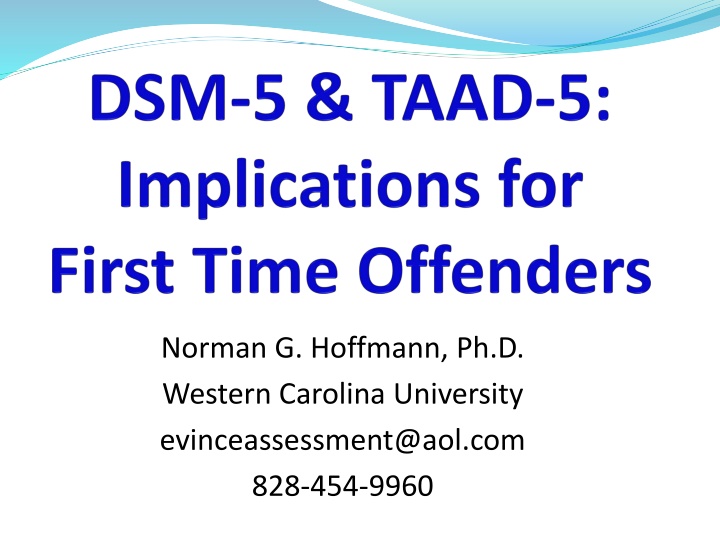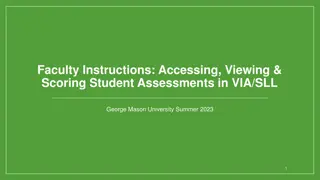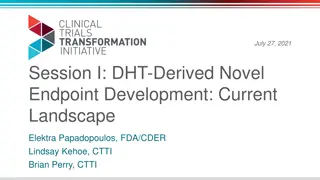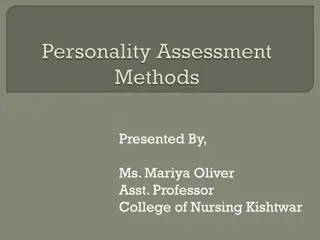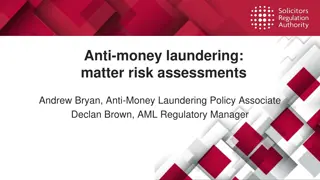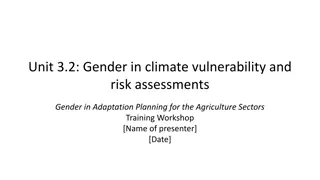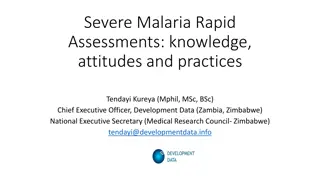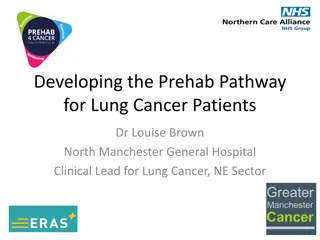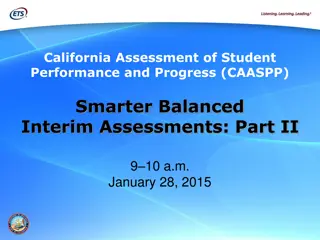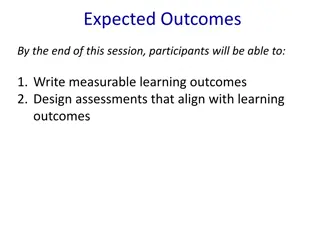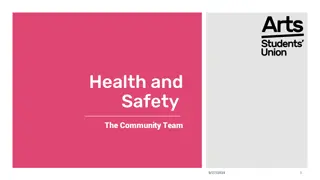Principles of Clinical Assessments
In clinical assessments, clinicians determine diagnoses based on comprehensive information gathered through screening, triage, and diagnostic assessments. Screening provides a quick estimate of a condition's probability, while triage covers all diagnostic criteria to make initial decisions. Diagnostic assessments delve deeper into criteria, enabling definitive diagnoses. Tools like UNCOPE aid in substance use disorder screening. Utilization of all available information is essential for accurate determinations.
Download Presentation

Please find below an Image/Link to download the presentation.
The content on the website is provided AS IS for your information and personal use only. It may not be sold, licensed, or shared on other websites without obtaining consent from the author.If you encounter any issues during the download, it is possible that the publisher has removed the file from their server.
You are allowed to download the files provided on this website for personal or commercial use, subject to the condition that they are used lawfully. All files are the property of their respective owners.
The content on the website is provided AS IS for your information and personal use only. It may not be sold, licensed, or shared on other websites without obtaining consent from the author.
E N D
Presentation Transcript
Norman G. Hoffmann, Ph.D. Western Carolina University evinceassessment@aol.com 828-454-9960
Overriding Principles Clinicians determine diagnoses assessment instruments don t Clinicians make decisions tools don t Instruments are tools to be used by clinicians to systematically gather information Clinicians should utilize all available information in making determinations including assessment results, legal records, and other corroborating information
Screening vs. Triage vs. Diagnostic Assessment Screening: short, fast, cheap estimate of probability that a person has a condition Triage: brief coverage of all diagnostic criteria to make initial decisions Diagnostic assessment: comprehensive coverage of all diagnostic criteria that when combined with all other sources of information allow clinicians to make a definitive diagnosis
WHEN TO SCREEN? Screen for what is NOT the presenting complaint or problem area. Screen for common problems other than the presenting complaint Addiction programs screen for MH MH clinics screen for addictions Follow with an assessment for the presenting complaint or problem areas identified by positive screen results.
The UNCOPE U Have you spent more time drinking/using than intended? (Unintended Use) N Have you ever neglected usual responsibilities because of using? C Have you ever wanted to cut down on drinking/using? O Has anyone objected to your drinking/use? P Have you found yourself thinking a lot about drinking/use? (Preoccupied) E Have you ever used to relieve emotional distress, such as sadness, anger, or boredom?
UNCOPE: A Brief Free Screen for Substance Use Disorders Six items used in screening adults and adolescents for any substance use disorder Free from Evince Clinical Assessments [research tab at www.evinceassessment.com] Two or more positive responses indicate risk for a severe substance use disorder Sensitivity for severe = 90% to 95% Specificity for severe = 90% to 95%
UNCOPE and the DSM-5 The first five UNCOPE items conform to five DSM-5 criteria: Criterion 1: U = unplanned use Criterion 5: N = role fulfillment failure Criterion 2: C = desire to cut down Criterion 6: O = interpersonal conflict Criterion 4: P = craving Item E = possible self-medication not a DSM-5 criterion
WHEN/WHERE TO TRIAGE? Need more than a screening probability estimate Results: negative finding; severe diagnosis; mild to moderate or unclear When limited time, circumstance, or task precludes a comprehensive assessment Emergency room settings DUI/DWI evaluations Initial inmate evaluation (e.g., jails) Follow with a comprehensive assessment if indicated/required
WHAT IS REQUIRED FOR TRIAGE Cover all of the diagnostic criteria Enable clinicians to exclude a diagnosis based on sufficient negative findings of key markers Confirm obvious diagnoses (especially severe) based on positive criteria findings Provide a concrete summary of positive findings that can be externally reviewed and confirmed by the appropriately trained clinician
WHEN IS A COMPREHENSIVE ASSESSMENT REQUIRED? Treatment intake screens are totally inappropriate and triages may be inconclusive for treatment planning purposes For court dispositions that might require treatment recomendations When litigation may be involved Any situation that requires a potentially life-altering decision
WHAT IS REQUIRED FOR A COMPREHENSIVE ASSESSMENT Thorough coverage of all diagnostic criteria with multiple questions Current and collateral findings regarding problem areas family, past records, etc. Mechanism for providing a checklist or narrative summary of DSM-5 criteria a numeric score on a scale is insufficient must be based on the specific DSM-5 criteria that are positive
Substance Use Disorder Criteria 1.Use in larger amounts or longer than intended 2. Desire or unsuccessful effort to cut down 3. Great deal of time using or recovering 4. Craving or strong urge to use 5. Role obligation failure 6. Continued use despite social/interpersonal problems 7. Sacrificing activities to use or because of use 8. Use in situations where it is hazardous
DSM-5 SUD Criteria continued 9. Continued use despite knowledge of having a physical or psychological problem caused or exacerbated by use 10.Tolerance 11. Withdrawal Criteria 1-4 relate to use; Criteria 5-8 relate to behavioral issues associated with use; Criteria 9-11 relate to physical/emotional issues
DSM-5 Initial VS. DSM-5 Final Initially the proposed DSM-5 had two diagnostic categories: moderate and severe defined by 2-3 and 4+ positive criteria Final formulation has three categories: mild (2-3), moderate (4-5), and severe (6+ positive criteria) Original moderate becomes mild No compelling empirical basis for cut points
Pros vs. Cons of theDSM-5 Pros The severe diagnosis identifies people who in all probability need to set abstinence as a goal The mild diagnosis will in most cases be those who do NOT need to have abstinence as a goal Provides a framework for making better treatment decisions based on collection of outcome findings Cons May give the impression that the severe diagnosis is simply a versions of the moderate and mild diagnoses The distinctions between diagnoses are not empirically derived and may not be the optimal points of discrimination
GENDER COMPARISON of DSM-5 ALCOHOL DIAGNOSES Males N = 6,871 Females N = 801 100% 100% 80% 80% 60% 60% Severe Severe 40% 40% Mod. Mod. Mild Mild 20% 20% No Dx No Dx 0% 0% Kopak, Metz, & Hoffmann (in press)
GENERAL COMPARISON of DSM-5 CANNABIS DIAGNOSES Males N = 6,871 Females N = 801 100% 100% 80% 80% 60% 60% Severe Severe 40% 40% Mod. Mod. Mild Mild 20% 20% No Dx No Dx 0% 0% Kopak, Proctor, & Hoffmann, 2012
GENERAL COMPARISON of DSM-5 COCAINE DIAGNOSES Males N = 6,871 Females N = 801 100% 100% 80% 80% 60% 60% Severe Severe 40% 40% Mod. Mod. Mild Mild 20% 20% No Dx No Dx 0% 0% Proctor, Kopak, & Hoffmann, 2012, in press
COMPARISON of DSM-5 DIAGNOSES FOR ADOLESCENTS Males N = 571 100% Females N = 333 100% 80% 80% 60% 60% Severe Severe 40% 40% Mod. Mod. Mild Mild 20% 20% No Dx No Dx 0% 0% Malone & Hoffmann, 2012
DSM-5 vs. DSM-IV Summary Almost all who did not get a DSM-IV-TR diagnosis will still not have a DSM-5 diagnosis The vast majority of those with a dependence diagnosis will fall into the severe designation of the DSM-5 Substantial changes will be seen for those now diagnosed with abuse Most will receive a diagnosis of mild substance use disorder A significant minority will no longer get a diagnosis A smaller minority will get a moderate diagnosis
Comparison of TAAD vs. SUDDS-IV DSM-IV Alcohol Diagnoses Males N = 6,871 100% Females N = 801 100% TAAD Dx 80% 80% TAAD Dx 60% 60% Dependence Dependence 40% 40% Abuse Abuse 20% 20% No Dx No Dx 0% 0% SUDDS-IV Diagnosis SUDDS-IV Diagnosis
Comparison of TAAD VS. SUDDS-IV DSM-IV Results SUDDS-IV is a longer and more comprehensive assessment (30-45 min.) TAAD is brief (10-15 min.) and is more specific for alcohol All TAAD classifications of dependence are confirmed by SUDDS-IV TAAD may underestimate dependence among abusers
TAAD VS. SUDDS-IV with Initial Alcohol DSM-5 Diagnosis Males N = 6,871 Females N = 801 100% 100% 80% 80% TAAD Dx TAAD Dx 60% 60% Mod-Sev Mod-Sev 40% 40% Mild Mild No Dx No Dx 20% 20% 0% 0% SUDDS-IV Diagnosis SUDDS-IV Diagnosis
Comparison of TAAD VS. SUDDS-IV DSM-5 Results All TAAD moderate to severe confirmed by the longer SUDDS-IV Compared to the DSM-IV results, the TAAD appears to miss more mild diagnoses This may be due to lack of craving and compulsion items on the original TAAD These are added to the TAAD-5 and may resolve this issue
DSM-5 Diagnostic Distribution for First-time DUI/DWI Offenders N = 658 8.8 9.7 No Dx Mild 54.1 Moderate Severe 27.4
Comparison of Diagnostic Results for First-time DUI Offenders N = 658 100% 80% DSM-5 Diagnoses 60% Severe Moderate 40% Mild 20% No Dx 0% Abuse Dependence DSM-IV-TR Diagnoses
Distribution of Positive DSM-5 Criteria N = 658 First-time DWI/DUI Offenders 30 26.9 27.2 54.1% No diagnosis 25 20 45.9% at least mild diagnosis 16.2 15 11.2 10 18.5% at least moderate diagnosis 6.5 5 2.9 3.2 3.3 1.5 1.1 0 0 1 2 3 4 5 6 7 8 9 +
Other Drug Use Given Alcohol DSM-5 Diagnosis 45 40 35 30 25 Cannabis Other Drug 20 Any Drug 15 10 5 0 No Dx Mild Moderate Severe
General DSM-5 Findings Most first-time DUI/DWI offenders will not receive a DSM-5 diagnosis due to: Elimination of legal problems Requirement for two positive criteria The moderate and severe diagnoses conform almost exactly to dependence for almost one in five first-time offenders Positive diagnostic findings for alcohol related to higher probability of drug use
DSM-5 CRITERIA Differentials on Inmate Populations All criteria are not equal in implications Some criteria are found almost exclusively among those in the severe alcohol or other substance use disorder diagnoses Other criteria are more common among the mild to moderate alcohol use disorder group Tolerance and dangerous use are actually common among those with no diagnosis
Distribution of Positive Alcohol Criteria for 6,871 Males DSM-IV Criteria Based on SUDDS-IV Results No Dx 1. Unplanned use 2% 2. Unable to cut down <1% 3. Time spent using 2% 4. Craving/compulsion 1% 5. Role failure <1% 6. Social Conflicts 3% DSM-5 Designations Pop. Prev. Mild 8% 4% 6% 3% 3% 13% Mod. 11% 7% 11% 7% 9% 14% Sev. 79% 88% 81% 89% 88% 70% 27% 21% 28% 21% 25% 34%
Distribution of Positive Alcohol Criteria for 6,871 Males DSM-IV Criteria Based on SUDDS-IV Results No Dx 7. Sacrifice activities <1% 8. Dangerous use 8% 9. Contraindications 3% 10. Tolerance 12% 11. Withdrawal <1% Self-medication 5% DSM-5 Designations Pop. Prev. Mild 2% 15% 10% 11% 3% 9% Mod. 9% 15% 11% 11% 7% 11% Sev. 89% 62% 76% 66% 90% 75% 23% 36% 30% 33% 19% 27%
Distribution of Positive Alcohol Criteria for 801 Females DSM-IV Criteria Based on SUDDS-IV Results No Dx 1. Unplanned use 3% 2. Unable to cut down 0% 3. Time spent using 0% 4. Craving/compulsion <1% 5. Role failure <1% 6. Social Conflicts 3% DSM-5 Designations Pop. Prev. Mild Mod. Sev. 80% 92% 92% 96% 90% 77% 8% 2% 1% <1% 5% 10% 9% 6% 7% 3% 5% 10% 31% 24% 26% 23% 26% 33%
Distribution of Positive Alcohol Criteria for Females DSM-IV Criteria Based on SUDDS-IV Results No Dx 7. Sacrifice activities <1% 8. Dangerous use 9. Contraindications 10. Tolerance 10% 11. Withdrawal 0% Self-medication DSM-5 Designations Pop. Prev. Mild 3% 8% 9% 5% 2% Mod. 4% 9% 10% 10% 3% Sev. 93% 77% 78% 75% 95% 25% 29% 32% 32% 20% 6% 3% % % % % %
Positive Alcohol Criterion within DSM-5 Diagnostic Designations DSM-5 Criteria Based on TAAD Results No Dx 1. Unplanned use 19% 2.Unable to cut down 3. Time spent using 4. Craving/compulsion <1% 5. Role failure <1% 6. Conflicts (interpersonal) DSM-5 Designations Mild 72% 14% 4% 3% 6% 28% Mod. 80% 38% 25% 12% 12% 74% Severe 98% 69% 62% 43% 74% 90% 2% 0 3%
Positive Alcohol Criterion within DSM-5 Diagnostic Designations DSM-5 Criteria Based on TAAD Results No Dx 7. Sacrifice activities 8. Dangerous use 11% 9. Contraindications 10. Tolerance 13% 11. Withdrawal Self-medication DSM-5 Designations Mild 8% 43% 5% 52% 5% 14% Mod. 22% 59% 17% 81% 12% 25% Severe 81% 83% 60% 86% 48% 61% 0 8% 0% 3%
SUD Criteria Prevalent in Mod. to Severe Rare if no Diagnosis The Big Five Wanting to cut down/unable to do so Craving with compulsion to use Sacrifice activities to use Failure at role fulfillment due to use Withdrawal symptoms
Clinical Implications of the Differential Criteria Patterns Different populations are consistent in the finding that the Big Five are predominately found among the more severely involved Some differences noted for time spent: Female inmates DUI/DWI offenders Population specific interpretations might be required for best clinical results
DSM-5 Criteria Differentials Is it the Number or the Pattern? All criteria are not equal in implications The pattern of positive criteria findings can suggest differential needs and prognoses Could the diagnostic discriminations based on the number of findings be less important than the pattern of positive results?
Sample of Alcohol Diagnostic Documentation Alcohol Diagnosis Diagnostic Criteria 1 2 3 4 5 6 7 8 9 10 11 Severe Case 1 X X X X X X X X Mild Case 2 X X X Case 3 X X X X X Moderate Moderate Case 4 X X X X X Cases 3 & 4 with the same diagnosis may have different prognoses if the Big Five are related to outcomes
CASE 3: Positive DSM-5 Criteria 3. Great deal of time using 10. Tolerance 1. Unplanned use: more or longer use 8. Use in hazardous situation (impaired driving) 6. Recurrent interpersonal conflicts Conclusions No loss of control indicated Misuse and possible irresponsible behavior Moderation may be a reasonable initial goal
CASE 4: Positive DSM-5 Criteria 4. Craving/compulsion to use 1. Unplanned use: more or longer use 5. Role obligation failures 2. Desire/efforts to cut down 7. Sacrificing activities to use Conclusions Loss of control indicated Positive on 4 of the Big Five Abstinence likely required for recovery
Implications for Disposition Education and brief counseling may be appropriate for majority of 1st time offenders For those with a diagnosis, the pattern may be as important as the number of positive criteria Those positive on any of the Big Five criteria should be carefully evaluated regarding the current and projected trajectory of their condition
Final Criticism of the DSM-IV Loss of control not required for a dependence diagnosis e.g., tolerance, spending time using, and occasionally drinking more/longer than intended got the chronic diagnosis Some abuse criteria are stronger indications of a serious condition than some dependence criteria Role obligation failure is a Big Five criterion Tolerance is often seen in mild cases or even among those with no diagnosis
Summary for DSM-5 The TAAD and SUDDS-IV produced similar results for the DSM-IV The TAAD did not approximate the DSM-5 as well necessitating development of the TAAD-5 We expect that the TAAD-5 will better match the results of the SUDDS-5 However, since the TAAD-5 is shorter, it may still underestimate severity in some cases severely affected
Indications of Drug Use Alcohol may not be the only substance of concern with 1st time offenders Marijuana use most common drug used about 10% not dependent vs. 25-40% of dependent (moderate to severe alcohol Dx) Cocaine use unusual for those not dependent on alcohol (severe alcohol use disorder) Use of multiple drugs provides even stronger evidence of probable diagnosis indicating need for abstinence as a treatment goal
General Issues of Validity Validity scales are of limited utility Validity scales themselves may be inaccurate Assessment challenge is to document indications of a substance use disorder Even if some responses are inaccurate, the overall indications might still be accurate Invalidity based on a validity scale does not provide grounds for legal or administrative dispositions
Issues of TAAD-5 Validity Concurrent validity of TAAD with the SUDDS-IV Findings of no diagnosis very likely to be accurate compared to extensive assessment TAAD findings of moderate to severe substance use disorder consistently confirmed by more extensive assessment Some underestimate of severity is likely to persist with the TAAD-5 due to its brevity
TAAD-5 Interpretation Strategy Accept a determination of no diagnosis or severe alcohol use disorder For mild or moderate alcohol use disorder, a relatively small proportion will have a more severe condition consider further inquiry if there is a questions of severity Multiple positive findings on Big Five items with a moderate diagnosis suggests a guarded prognosis with possible emergence of a more serious problem
Referral/Disposition Model Based on empirical evidence Assumes policies and regulations are flexible Uses the diagnostic and assessment findings to drive referral/disposition options Incorporates existing monitoring technologies Motor vehicle interlocks SCRAM (Secure Continuous Remote Alcohol Monitoring) monitors alcohol secretion via an ankle bracelet and reports results via modem Telemetry breathalyzer
